The Chinese Middle Ages (220 ∼ 581 AD)
The Three Kingdoms Period 220 ∼ 280 AD
- Wei 220 ∼ 265 AD
- Shu Han 221 ∼ 263 AD
- Wu 222 ∼ 280 AD
Jin Dynasty 265 ∼ 420 AD (Carried over from Wu Kingdom)
- Western Jin 265 ∼ 316 AD
- Eastern Jin 317 ∼ 420 AD
Southern Dynasty 420∼589 AD |
Northern Dynasty 386∼581 AD |
(Carried over from Eastern Jin and ruled Southern China)
|
(Ruled Northern China)
|
About the Chinese Middle Ages
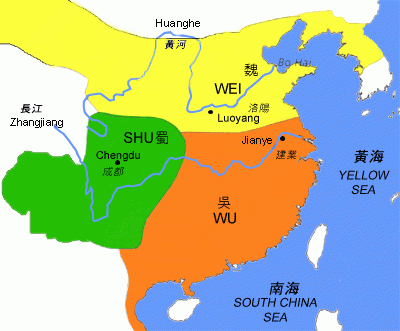
During this time, the Northern Chinese were considered to be more militant and less sophisticated than their Southern counterparts. At the same time, Buddhism was rapidly spreading throughout all parts of China. The Northern Wei especially welcomed the religion's presence because it was seen as a way to consolidate power. Buddhism also led to the influx of Indian culture into China.
As a result, knowledge concerning mathematics, astronomy and medicine flourished during this period. Many monks had medical knowledge because it was a necessity when making long pilgrimages to be able to administer medical care when no doctors were available.
Development of Chinese medicine was blooming in all aspects, that based on the medical achievements in the Han Dynasty, people accumulated sufficient medical knowledge and experiences, and so published a lot of great books, especially in the field of pulse study, acupuncture and moxibustion, Materia Medica and herbal prescriptions.
Development of Physician Education
During this time, medical education was elevated to a higher standard. In 443 AD, Qin Cheng-zu, an imperial medical officer, petitioned Emperor Wen of the Song Kingdom to appoint physicians to teach medical students. It was the first time the government assigned teachers to educate students on Chinese medicine. Although the Imperial Academy was established in 124 BC, it mainly focused on teaching subjects such as literature, philosophy and administration. Little emphasis was placed on medicine. However, by 493 AD, the Imperial Academy had expanded to include lectureships and chairs for teaching Chinese medicine.
Acupuncture and Moxabustion
Acupuncture, known as zhen jiu in Chinese, was widely accepted by the Chinese population. Its use may have originated out of the Chinese fascination of relieving referred pain, defined as pain that manifests in one part of the body but originating from somewhere else. Many of the physicians mentioned previously such as Bian Que, Zhang Zhongjing, Hua Tuo, and Fan A used this therapy when treating patients. The Vital Axis, a book from the Yellow Emperor’s Classic of Internal Medicine has a whole section dedicated to the use of accupuncture.
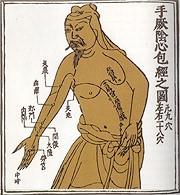
The man who wrote what is considered the bible of accupuncture and moxibustion was Huangfu Mi (215∼282 AD). His biggest contribution was a book called ABC of Acupuncture and Moxibustion (zhen jiu jia yi jing), which is considered to be the earliest complete reference guide to acupuncture and moxibustion. This book starts by discussing TCM concepts involving anatomy, and physiology and progresses to describing the theory of meridians. In addition, it outlines the location of the acupuncture points, discusses the techniques used to manipulate the needles, and describes the clinical applications and therapeutic benefits of both acupuncture and moxibustion.
Meridian and Pulse Study
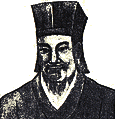
By now the concept of blood and circulation was fully entrenched in the practice of Chinese medicine. It was thought that there were two separate systems of circulation within the body, each with a different fluid flowing though it. Blood was known to pump from the heart and into vessels throughout the body. Qi was considered a form of energy that pumped from the lungs, and circulated throughout the body on invisible tracts called meridians. Wang Shuhe (265 ∼ 317 AD) , the Promoter of Pulsing wrote the Pulse Classic (mai jing),which was a compilation of all the knowledge on pulse diagnosis up to this point in history. In Chinese medicine feeling the pulse is perhaps the most important examination technique used when diagnosing a patient because how a pulse feels indicates different illnesses. In this book, 24 different kinds of pulses were identified.
Alchemy and Ge Hong
 Alchemists can be considered the first pharmacists. Their popularity arose out of the Taoists quests for longevity. In their search for the magic elixir of life, alchemists would experiment with different methods of combining chemicals and minerals to create new medicines or tonics.
Alchemists can be considered the first pharmacists. Their popularity arose out of the Taoists quests for longevity. In their search for the magic elixir of life, alchemists would experiment with different methods of combining chemicals and minerals to create new medicines or tonics.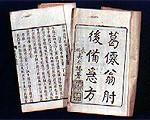
Materia Medica
Another important figure in the development of Chinese medicine was Tao Honjing (456〜536 AD), who was especially renowned for his commentaries on the Shen Nong'sClassic of Herbal Medicine. He increased the number of listed herbal medicines in the book from 365 to 730, and furthered the information on the herbs' nature, location, and time of harvesting. The new book was entitled Variorum of the Classic of Herbal Medicine (shen nong ben cao jing hiz zhu). It dominated the pharmaceutical literature until the middle of the 7th century AD. He also completed Ge Hong's Prescriptions for Emergency, which was re-titled 101 Emergency Prescriptions (zhou hou bai yi fang).
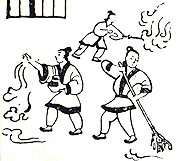 These prescriptions and those of other alchemists and Chinese doctors were often circulated using handwritten copies. Sometimes they would also be carved into the stone caves that served as Buddhist sanctuaries. One example is the Buddhist caves of Longmen (also called Dragon's Gate located south of Loyang in Henan province). There you can find approximately 100 prescriptions carved into the walls near the end of the 6th century AD. Ge Hong's use of dichroa febrifuga for the treatment of malaria is an example of one such prescription carved at this location.
These prescriptions and those of other alchemists and Chinese doctors were often circulated using handwritten copies. Sometimes they would also be carved into the stone caves that served as Buddhist sanctuaries. One example is the Buddhist caves of Longmen (also called Dragon's Gate located south of Loyang in Henan province). There you can find approximately 100 prescriptions carved into the walls near the end of the 6th century AD. Ge Hong's use of dichroa febrifuga for the treatment of malaria is an example of one such prescription carved at this location. Other Important Medical Contributions
Other important Chinese medical works of this time are Lei Xiao's (born in 15 AD) Lei's Treatise on Medicinal Processing (lei gong bao zhi lun) and The Left Prescriptions by Liu's (liu juan zi wei fang). Lei's Treatise on Medicinal Processing focused on the vegetable-based medicines unlike Ge Hong's work that focused on chemical remedies to cure illnesses. In addition, this book outlines the various ways of preparing these medicines such as cooking them over an open fire , steaming or boiling them . The Left Prescriptions by Liu's is the earliest known treatise on Chinese surgery, which provides a wealth of information on the experiences gained up to the fifth century in the treatment of wounds caused by metal instruments and of ailments affecting the skin such as boils, anthrax and abscesses. The use of mercurial ointment is mentioned for curing certain skin conditions.



